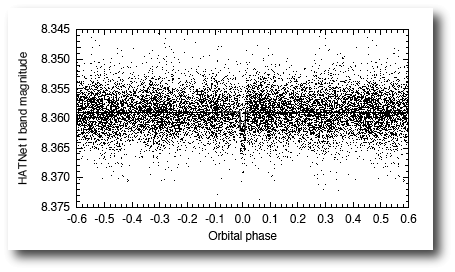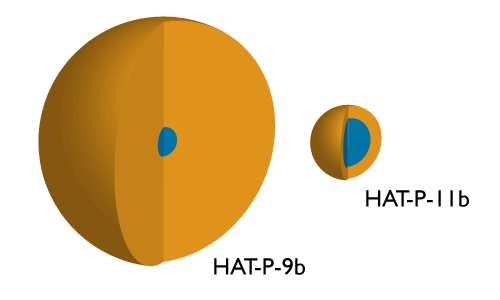
and at 880K it’s close to ten times hotter (but likely the same color) as the original edition.
In the twenty months following Gillon et al.’s startling discovery that Gliese 436b is observable in transit, literally dozens of additional transiting planets have been found. New transiting hot Jupiters are now routine enough that they’re generally trotted out in batches. Reported cases of transit fever have also been on the decline, with symptoms often amounting to little more than a passing distraction.
That said, it’s been been a very long dry spell waiting for a second example of a transiting Neptune-mass planet, which makes HAT-P-11b both exciting and newsworthy. In a preprint that muscled its way to the top of today’s astro-ph mailing, Gaspar Bakos and collaborators have produced a admirably solid analysis of what’s definitely the toughest ground-based detection to date.

HAT-P-11b’s transit depth is 4.2 millimag, which is the smallest planet-produced dip yet detected by a photometric survey. (HD 149026b has a smaller transit depth, but it was discovered via the Doppler velocity method and then followed up photometrically for the transits during the time windows predicted by the orbital solution.) The HAT-P-11b analysis was further confounded by a photometrically variable parent star and ~5m/s stellar jitter on the radial velocity observations. The paper is definitely worth reading carefully.
HAT-P-11b is quite similar in mass and radius to Gliese 436b, and it’s actually somewhat larger than Neptune on both counts. When the mass and radius are compared to theoretical models, it’s clear that, like Gliese 436, it’s mostly made of heavy elements (that is, some combination of metal, rock and “ice”) with an envelope of roughly 3 Earth masses of hydrogen and helium). It’s completely dwarfed when placed next to an inflated hot Jupiter, HAT-P-9b, for instance:

Interestingly, HAT-P-11b seems to have a significant eccentricity, on the order of e=0.2. Drawn to scale with the parent star, the orbit looks like this:

The dots demarcating the orbit are not to scale. With 500 pixels of resolution, you can just barely see the planet. (I put one in front of the star, and tacked a copy onto the orbit for good measure.)
The e=0.15 eccentricity of Gliese 436b has caused a lot of consternation. For any reasonable value of the so-called tidal quality factor, Q, the circularization timescale for Gliese 436b’s orbit is considerably shorter than the age of the system. This has led to attempts (to date unfulfilled) to locate Gliese 436c. HAT-P-11b doesn’t have this problem. For a given Q, it’s circularization timescale is a full thirty times longer than that of 436b. The orbit will still be measurably eccentric even when the 0.8 solar mass primary starts to turn into a red giant.

The preprint is up at the arXiv. Your last comment made me wonder if Bakos hadn’t found an exo-Earth in transit. A transiting Neptune is still a *hot* find, but your cryptic post almost made me freak-out with the tension.
Off-topic here, but the feed for this blog doesn’t work – it looks like there’s an invalid character in the post “That Sunday Afternoon Feeling” at the end of the sentence starting “As the Milky Way’s stellar population ages…”